Vietnamese Architecture Style - Evolution Through The Ages
One in the world, a Southeast Asian nation shaped like a dragon, Vietnam has long been a top choice for tourists looking for life-changing experiences. If you come to Vietnam, you will have a unique travel experience with its breathtaking scenery, mouth watering food and turbulent past. Vietnam is home to stunning terraced rice fields and immaculate beaches; but there is one thing that travelers might miss while traveling, is Vietnamese architecture style.
Many Vietnamese buildings were influenced by France architecture through historical periods. Moreover, every structure in Vietnam, temple and palace has its own history and unique designs. Now, let’s find out all the Vietnamese architecture styles that you can visit in this country.
Vietnam Traditional Architecture
The living evidence of a period when spiritual ideas and the interaction between humans and environment were fundamental to building design is found in traditional Vietnamese architecture. This design, which is the result of a careful mixing of building methods and philosophical ideas from people in the past, captures the essence of Vietnamese culture.
Traditional Vietnamese architecture style always uses carefully selected materials that complement the region's resources and tropical climate. The main components were terracotta tile, bamboo and wood. Particularly wood was widely used in building, giving architects tremendous flexibility and the ability to adjust to shifting weather conditions.
In the past till now, feng shui architecture played an important role when building a house. Using natural forms and symbols like rivers, mountains and waves, buildings were created to blend in with their surroundings. On the other hand, Feng Shui prescribed how structures should be arranged to optimize energy balance and tenant well-being.
Tran Dynasty
The Vietnamese architecture style of the Tran dynasty can be observed in old citadels, pagodas and antique homes. There are currently available works at Thai Lac Pagoda (Hung Yen province), Pho Minh Tower (Nam Dinh province) and Binh Son Tower (Vinh Phuc province).
A good example of the art form throughout the Tran dynasty and the centuries that followed is the Pho Minh temple's compound and construction. The foyer, main hall and worshiping sanctuary were the three primary sections of the building's design. An integral aspect of the entire structural complex is the interior yard and garden. It displays the opinion of the universe.
>>> Read more about exploring Vietnam's historical sites!
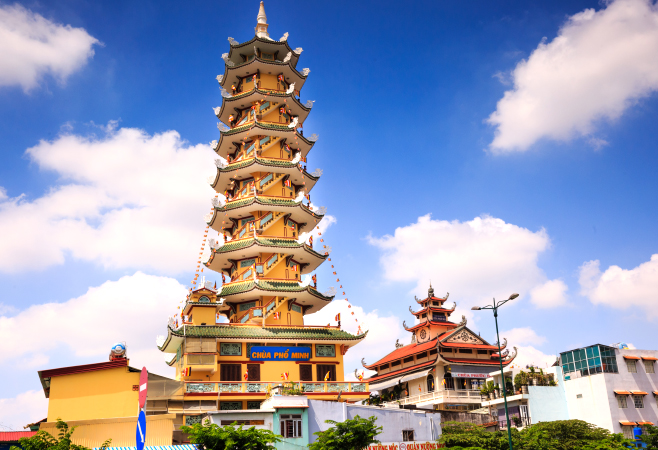
Pho Minh Tower
Le Dynasty architecture
The Le Dynasty, which flourished in the 16th and 17th centuries, gave rise to the folk art and sculpture that are used in contemporary carvings and paintings.
The two most notable buildings of the time are the Tay Phuong Pagoda and the Bang Communal House. The last major kingdom was the Nguyen dynasty, which relocated the capital from Thang Long to Hue in central Vietnam.
Although the earlier practice of building wooden homes is still present, the structures built during this era appear more slender and light. They also feature multiple roof levels and are decorated with floral, dragon and phoenix motifs. Because up to eight layers of porcelain and ceramic (known as Co-Diem) fill up the spaces between the layers, the roofs appear lighter as a result.
>>> Read more about UNESCO World Heritage Sites In Vietnam!
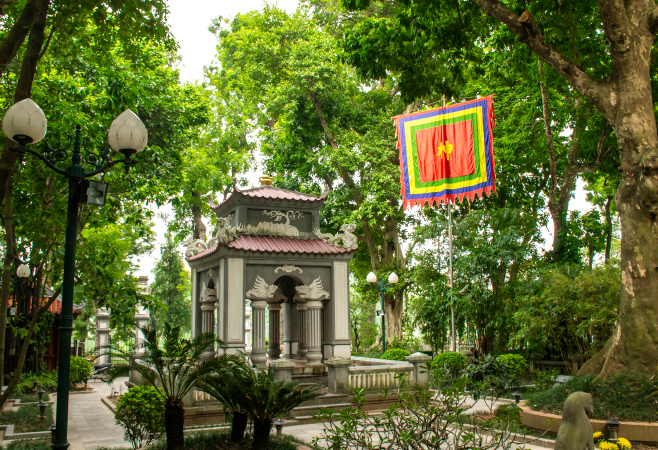
Inspiration architecture in Le Dynasty
Nguyen Dynasty - The famous Vietnamese Architecture Style
Vietnam's Nguyen Dynasty architecture can be found on the building and architecture of Hue Citadel (Hue Imperial City), Ngoc Son Temple and a portion of the Temple of Literature. It spans the early 17th and early 19th centuries.
Growth in the North came to a halt when Hue was made the capital of the Nguyen Dynasty. The Khue Van Cac pavilion, the Ngoc Son temple and other buildings were built in Thang Long. On the other hand, the Hue project included the construction of a garden-house complex. The architecture of the still-existing citadels, palaces, tombs and garden houses in Hue differs from that of the tube-shaped structures in Ha Noi.
>>> Explore Hanoi's One Pillar Pagoda - Chua Mot Cot!
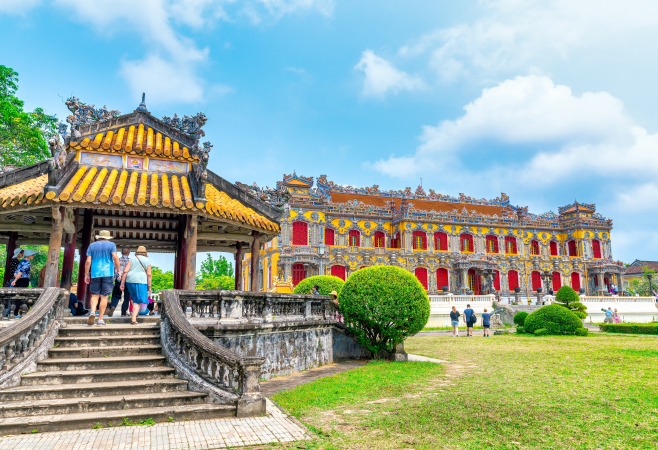
Hue Imperial City is the most beautiful preservation architect until now
France Architecture During Colonial Legacy
Vietnam has the deep and enduring legacy of French colonization. As part of French Indochina, France began to exercise political and economic influence over Vietnam in the middle of the 19th century. The nation's architecture was notably altered throughout this era of dominance, which also changed the social and economic makeup of the nation.
As the Saigon Post Office and the Hanoi Opera House Hanoi's French neighborhood features villas lining a tree-lined promenade that date back more than a century. The tendency of French Colonial architecture was born because of the abundance of exquisite French buildings combined with the allure of the East. As you stroll past the Université Indochinoise, the Presidential Palace, the Museum of Vietnam History and the Central Court in Hanoi, etc.
Moreover, the most remarkable thing is the way Vietnamese customs and French architectural features were combined to create extraordinary Vietnamese colonial architecture. Subtle details like the use of traditional Vietnamese tiles on French-style structures are examples of this fusion, which results in a distinctive aesthetic that represents the harmony between two separate cultures.
The Phat Diem Cathedral in the Ninh Binh area is the ideal illustration of this confluence. Under the direction of Father Tran Van Luc, popularly referred to as "Father Six", this massive edifice comprising five chapels and three man-made caves was built.
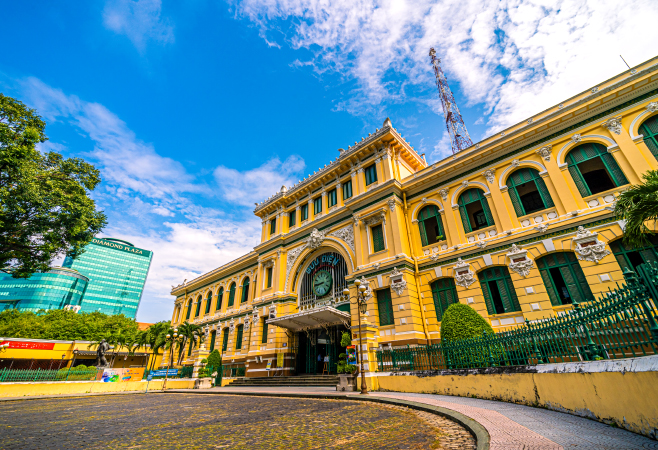
Saigon Post Office has France architecture style
Modern Vietnamese Architecture Style
As Vietnam keeps making investments in the travel industry, several new structures have appeared all throughout the country. This architectural style may have originated in Vietnam following the French expulsion from their colony in the mid-1900s. Following independence, a sophisticated fusion of traditional Vietnamese characteristics and Western styles like modernism and brutalism emerged in architecture. Vietnamese modern architecture has made an effort to respect the nation's rich cultural legacy while reflecting the nation's desire to modernize.
Huge structures with breathtaking views of the constantly shifting skyline are currently being built in major cities. The entire city is visible from Landmark 81, the tallest tower in Vietnam at 461 meters. The construction of this massive skyscraper began in 2015 and was completed in 2018.
Another towering structure that is iconic in Ho Chi Minh City is the Bitexco Financial Building. The well-known Dragon Bridge and Golden Hands Bridge in the progressive city of Da Nang are well-liked photo ops and symbols of Vietnam's relentless increasing drive.
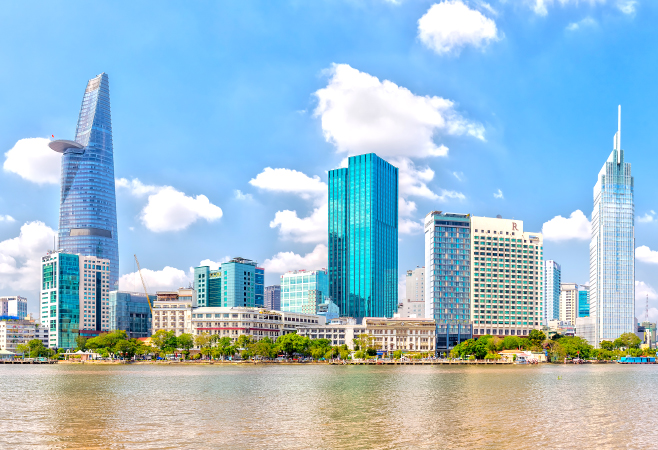
Modern landmarks in Vietnam
Conclusion: Vietnam Traditional Architecture
We have learned how traditional Vietnamese architecture is a live link to the past and demonstrates human ability in adapting to the environment through our trip through the eras and styles. French colonialism has left its mark, skillfully fusing French and Vietnamese styles, while modern architecture struggles to preserve tradition while adapting to modern demands. When you come to Vietnam, you will often have the chance to witness a vast array of Vietnamese architecture styles.
Ready to experience? Let’s apply for Vietnam e-visa to make your dreams come true. With our support of Vietnam Immigration Services, you can get your e-visa within a few days and travel to Vietnam legally. We will standardize documents and make your visa application successful. By that way, you no longer have to visit the Embassy to apply for a visa. With just simple clicks and you can do it at your home, travelers can have your travel documents without any difficulty.
Related Articles
- Official Vietnam Flag: History, Meaning, Colors, and Usage
- Phu Quoc Weather: Best Time to Visit & Seasonal Travel Guide
- Moc Chau: Highland paradise of tea hills & cultural adventures
- Team building and CSR activities in Vietnam: Visa services
- Honeymoon in Vietnam: Best romantic packages for couples
- Amanoi Resort in Vietnam: Luxury retreat in Vinh Hy Bay
- Six Senses resorts in Vietnam: Ninh Van Bay and Con Dao
- Con Dao Island: A historical and natural paradise in Vietnam
HOW CAN WE HELP?
APPLY WITH CONFIDENCE










